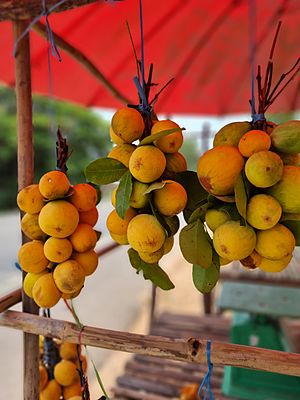Willughbeia edulis facts for kids
Quick facts for kids Willughbeia edulis |
|
|---|---|
 |
|
| Willughbeia edulis, known as Kouy fruit, for sale in Cambodia | |
| Scientific classification | |
| Genus: |
Willughbeia
|
| Species: |
edulis
|
| Synonyms | |
|
|
Willughbeia edulis is a type of vine that grows delicious tropical fruit. It belongs to the plant family called Apocynaceae. This plant is special because its fruits are one of the few edible ones among climbing plants in Southeast Asia.
What's in a Name?
The name Willughbeia honors a famous English scientist named Francis Willughby. He was an expert in birds and fish. The second part of the name, edulis, comes from Latin and simply means "edible" or "can be eaten." So, its name tells us it's a plant named after a person, and its fruit is good to eat!
About the Kouy Fruit Plant
This plant produces a yellow, somewhat sour, but tasty fruit. You can find Willughbeia edulis growing in many parts of Asia. It's common in countries like India, Cambodia, Myanmar, Thailand (especially in the Isan region and Chanthaburi Province), Vietnam, and Peninsular Malaysia. Sometimes, people might also call it "Willughbeia cochinchinensis".
The stems of the plant are reddish and have small spots. If you cut the stems, a milky liquid called latex comes out. This latex can be used to make a type of rubber known as chittagong. The roots of the plant can also be used to make a red dye. In some parts of Asia, like Cambodia, people have traditionally used parts of this plant for medicine.
Local Names for Kouy Fruit
Because this fruit grows in many different countries, it has lots of local names!
- In Cambodia, it's called kuy (គុយ).
- In India, you might hear it called gedraphol, laleng-tenga, or bel-tata.
- In Thailand, some names include dton-kuy (ต้นคุย), kuiton (เถาคุย), kreua (เครือ), and katong-katiew (กะตังกะติ้ว).
- In the Isan dialect of Thailand, it's known as bak yang-pa (บักยางป่า).
- In Myanmar, it's called talaing-no.
- In Vietnam, people call it guồi.
There's also a similar fruit called Kubal madu in Indonesia. This fruit comes from a related plant, W. sarawacensis, which is also edible.

